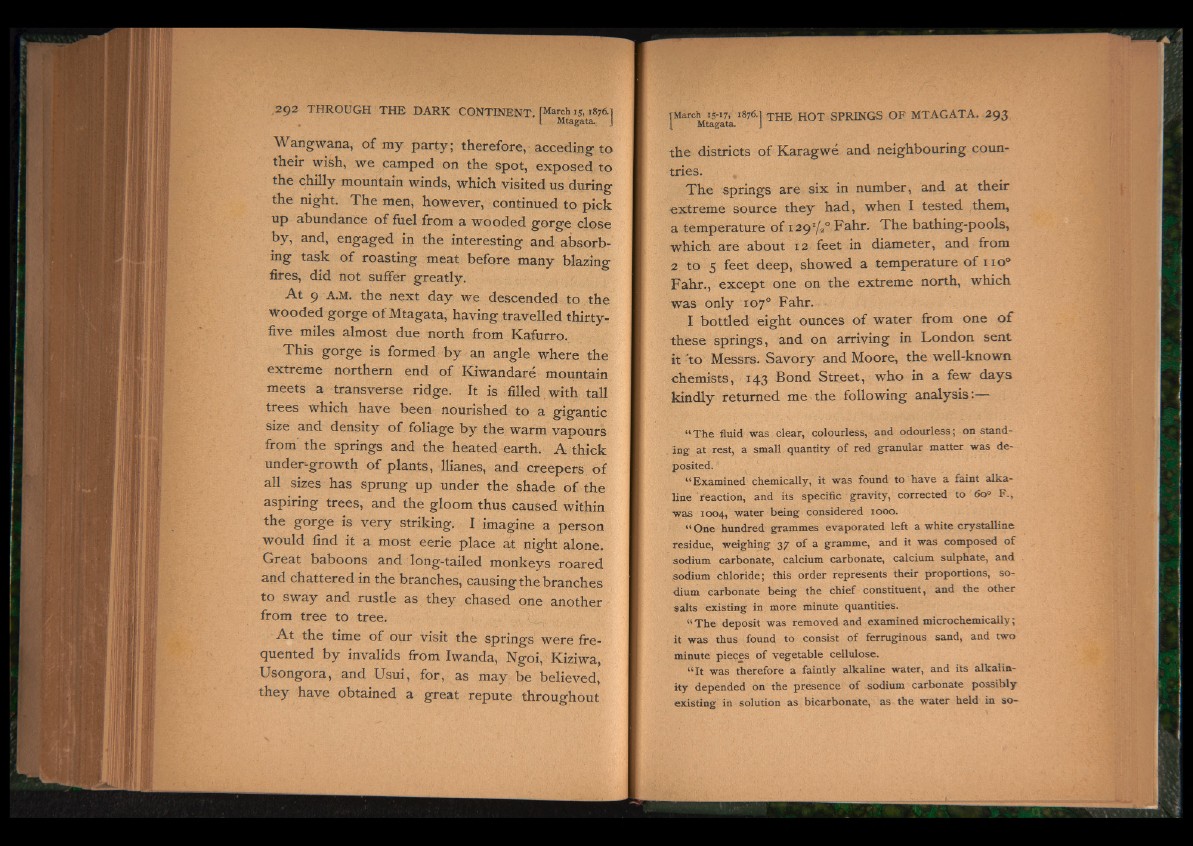
Wangwana, o f my party; therefore,; acceding to
their wish, we camped on the spot, exposed to
the chilly mountain winds, which visited us during
the night. T he men, however, continued to pick
up abundance o f fuel from a wooded g o rg e close
by, and, engaged in the interesting and absorbing
task o f roasting meat before many blazing
fires, did not suffer greatly.
A t 9 A.M. the next day we descended to the
wooded gorg e o f Mtagata, having travelled thirty-
five miles almost due north from Kafurro.
This g o rg e is formed b y an angle where the
extreme northern end o f Kiwandare mountain
meets a transverse ridge. It is filled with tall
trees which have been nourished to a gigantic
size and density o f foliage b y the warm vapours
from'the springs and the heated earth. A thick
under-growth o f plants, llianes, and creepers o f
all sizes has sprung up under the shade o f the
aspiring trees, and the gloom thus caused within
the go rg e is v e ry striking. I imagine a person
would find it a most eerie place at night alone.
Great baboons and long-tailed monkeys roared
and chattered in the branches, causing the branches
to sw ay and rustle as they chased one another
from tree to tree.
A t the time o f our visit the springs were frequented
b y invalids from Iwanda, Ngoi, Kiziwa,
Usongora, and Usui, for, as may be believed,
th e y have obtained a great repute throughout
tMarch 15-17, 1876.] THE HOT SPRINGS OF MTAGATA. 293
Mtagata. J
the districts o f Karagwe and neighbouring countries.
T he springs are s ix in number, and at their
extreme source they had, when I tested them,
a temperature o f 129Y20 Fahr. The bathing-pools,
which are about 12 feet in diameter, and from
2 to 5 feet deep, showed a temperature o f 11 o°
Fahr., except one on the extreme north, which
was only 107° Fahr.
I bottled eight ounces o f water from one o f
these springs, and on arriving in London sent
i t 'to Messrs. S a vo ry and Moore, the well-known
chemists, 143 Bond Street, who in a few d ays
kindly returned me the following analysis:—
“ The fluid was clear, colourless, and odourless; on standing
at rest, a small quantity of red granular matter was deposited.
“ Examined chemically, it was found to have a faint alkaline
reaction, and its specific gravity, corrected to 60° F.,
was 1004, water being considered 1000.
“ One hundred grammes evaporated left a white crystalline
residue, weighing 37 of a gramme, and it was composed of
sodium carbonate, calcium carbonate, calcium sulphate, and
sodium chloride; this order represents their proportions, sodium
carbonate being the chief constituent, and the other
salts existing in more minute quantities.
“ The deposit was removed and examined microchemically;
it was thus found to consist of ferruginous sand, and two
minute pieces of vegetable cellulose.
“ It was therefore a faintly alkaline water, and its alkalinity
depended on the presence of sodium carbonate possibly
existing in solution as bicarbonate, as the water held in so